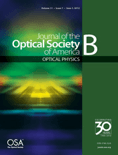
JOURNAL OF THE OPTICAL SOCIETY OF AMERICA B-OPTICAL PHYSICS
Scope & Guideline
Transforming Understanding in Nonlinear Optical Phenomena
Introduction
Aims and Scopes
- Quantum Optics and Photonics:
Exploration of quantum phenomena in optics, including quantum entanglement, quantum state preparation, and quantum key distribution, often leveraging advanced materials and novel light manipulation techniques. - Nonlinear Optics:
Research into the interactions of light with matter under intense fields, leading to phenomena such as second-harmonic generation, solitons, and supercontinuum generation, crucial for developing new laser technologies. - Metamaterials and Nanophotonics:
Investigation of engineered materials with tailored optical properties, including plasmonic structures and metamaterials, enabling novel applications in sensing, imaging, and light manipulation. - Optical Sensors and Imaging Systems:
Development of advanced sensor technologies based on optical principles, including fiber optics, spectroscopy, and imaging techniques for applications in medical diagnostics and environmental monitoring. - Optical Materials and Devices:
Study of new materials for optical applications, including nonlinear crystals, photonic crystals, and integrated optical devices, aimed at enhancing device performance and functionality. - Terahertz and Mid-Infrared Technologies:
Exploration of terahertz and mid-infrared light applications, including generation, detection, and manipulation techniques for spectroscopy and imaging. - Light-Matter Interactions:
Fundamental studies of how light interacts with various media, including atomic, molecular, and solid-state systems, to understand and control quantum states and dynamics.
Trending and Emerging
- Artificial Intelligence and Machine Learning in Optics:
The integration of AI and machine learning techniques in optical research is on the rise, facilitating advancements in design optimization, imaging, and data analysis, enhancing efficiency and discovery in optical applications. - Integrated Photonics and On-chip Devices:
Research on integrated photonic circuits and devices is gaining momentum, driven by the demand for compact and efficient optical systems for telecommunications, sensing, and quantum computing. - Quantum Technologies:
The focus on quantum technologies, including quantum communication, quantum sensing, and quantum computing, is rapidly increasing, reflecting the growing interest in harnessing quantum mechanics for practical applications. - Advanced Metasurfaces and Photonic Crystals:
Research into metasurfaces and photonic crystals is expanding, with applications in light manipulation, sensing, and imaging, driven by the need for novel optical components that outperform traditional optics. - Terahertz Science and Technology:
There is a notable increase in research related to terahertz technologies, including generation, detection, and applications in spectroscopy and imaging, highlighting the potential of the terahertz frequency range. - Hybrid Photonic Systems:
The exploration of hybrid systems combining different optical technologies (e.g., plasmonics and photonics) is emerging as a significant trend, offering new functionalities and enhanced performance in various applications.
Declining or Waning
- Classical Optics:
Research focused on traditional aspects of classical optics, such as geometric optics and wave optics, has seen a decline as the field increasingly shifts towards quantum optics and advanced photonic technologies. - Linear Optical Devices:
The interest in purely linear optical devices has waned as researchers pursue more complex systems that exploit nonlinear effects, leading to advancements in optical computing and communications. - Fundamental Optical Phenomena:
While foundational studies remain important, there is a noticeable decrease in publications dedicated solely to classical phenomena without applications in novel technologies, as the field moves towards more applied research.
Similar Journals

OPTICAL AND QUANTUM ELECTRONICS
Connecting Theory and Application in Quantum ElectronicsOPTICAL AND QUANTUM ELECTRONICS, published by SPRINGER, is a premier journal dedicated to advancing the fields of atomic and molecular physics, optics, and electronic engineering. With an ISSN of 0306-8919 and an E-ISSN of 1572-817X, this journal has established itself as a vital resource for researchers, professionals, and students alike, contributing to the discourse from its inception in 1969 to its continued publications through 2024. It holds impressive rankings in Scopus, placing within the top percentiles for its categories, specifically in the 64th for Electrical and Electronic Engineering and 63rd for Atomic and Molecular Physics. Though it does not currently offer open access options, the journal's robust impact factor reflects its importance within its field, making it an essential reference point for cutting-edge research and developments in materials science and optics. Through its rigorous peer-review process, OPTICAL AND QUANTUM ELECTRONICS remains committed to publishing high-quality, influential studies that push the boundaries of innovation and understanding in these dynamic areas of science.

PhotoniX
Pioneering Discoveries in Photonics and BeyondPhotoniX is a premier open-access journal published by SPRINGERNATURE in Germany, dedicated to the fields of Atomic and Molecular Physics, Optics, and Electrical and Electronic Engineering. Launched in 2020, this journal has swiftly established itself as a key resource within the scientific community, achieving impressive rankings, notably being placed in the Q1 quartile across its categories in 2023. With its Scopus ranks highlighting its excellence—2nd in Engineering (Miscellaneous), 9th in Electrical and Electronic Engineering, and 6th in Atomic and Molecular Physics—PhotoniX serves as a critical platform for researchers to disseminate their findings. With an emphasis on broadening access to cutting-edge research, the journal offers a valuable opportunity for engagement with contemporary advancements in the fields it covers. Researchers, professionals, and students can benefit significantly from its contents, contributing to the collective knowledge in these vital areas of science and technology.
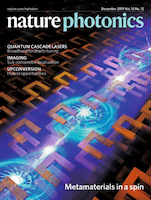
Nature Photonics
Driving the Evolution of Photonics through Collaborative ResearchNature Photonics, published by NATURE PORTFOLIO, stands as a leading journal in the realm of photonics, specializing in the convergence of atomic and molecular physics and optics, as well as electronic, optical, and magnetic materials. Established in 2007 and continuing through 2024, this esteemed journal boasts an impressive 2023 ranking of Q1 in both its primary categories, highlighting its importance and influence within the scientific community. With a Scopus rank of #3 in both materials science and physics categories, and a remarkable 99th percentile ranking, Nature Photonics serves as a vital platform for disseminating pioneering research and innovative discoveries that drive the field forward. Although it does not currently offer open access options, the journal remains accessible to a broad audience interested in the latest advancements in photonics, including researchers, professionals, and students eager to explore cutting-edge developments. By fostering a community of collaboration and knowledge exchange, Nature Photonics continually shapes the future of photonics research.

eLight
Shining a Light on Experimental and Theoretical BreakthroughseLight is a leading academic journal published by SPRINGER NATURE, dedicated to the dynamic field of Atomic and Molecular Physics, as well as Electronic, Optical, and Magnetic Materials. Launched in 2021, the journal has quickly established itself as a reputable source of cutting-edge research, evidenced by its impressive Q1 quartile rankings in both categories for 2023, alongside remarkable Scopus rankings that place it in the top 2% of its fields. With a commitment to advancing knowledge and fostering innovation, eLight invites contributions from researchers, professionals, and students who are passionate about exploring new frontiers in these critical areas of study. Hitting a critical intersection of physics and materials science, the journal provides an open forum for the dissemination of experimental findings, theoretical studies, and application-based research, ensuring accessibility to vital discoveries that drive progress in technology and academia. Located in Singapore, eLight is poised to make significant contributions to the scientific community until at least 2024, and beyond.
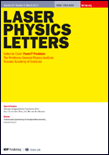
LASER PHYSICS LETTERS
Fostering Excellence in Laser ScienceLASER PHYSICS LETTERS is a prestigious peer-reviewed journal published by IOP Publishing Ltd in the United Kingdom, focusing on the burgeoning field of laser physics and its applications. With an ISSN of 1612-2011 and an E-ISSN of 1612-202X, this journal stands at the intersection of innovative research and practical applications, addressing diverse topics within the realms of Instrumentation and Physics and Astronomy. Recognized for its impactful contributions, it boasts a ranking within the Q3 quartile for both relevant categories as of 2023, reflecting its steady rise and commitment to advancing knowledge in the area. Researchers and practitioners are encouraged to explore its content and contribute to the ongoing discourse that shapes the future of laser technologies. While LASER PHYSICS LETTERS does not currently offer open access options, its rigorous selection criteria ensure that published work is of the highest quality, positioning it as a vital resource for anyone engaged in laser science and engineering.
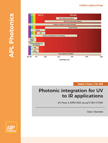
APL Photonics
Connecting Innovators in Photonics ResearchAPL Photonics is a premier open-access journal published by AIP Publishing, dedicated to the field of photonics, encompassing a broad range of research areas including atomic and molecular physics, optics, and computer networks and communications. Since its inception in 2016, the journal has positioned itself at the forefront of innovation, earning Q1 quartile rankings in both relevant categories as of 2023. With an impressive Scopus ranking that places it in the 87th and 89th percentiles for its respective fields, APL Photonics serves as a vital platform for rapid dissemination of high-impact research. Its open-access policy ensures that cutting-edge findings are accessible to researchers, professionals, and students globally, facilitating collaboration and knowledge sharing. Aimed at fostering advancements in the photonics community, this journal is essential for those looking to stay informed on the latest breakthroughs and trends in photonic technologies.
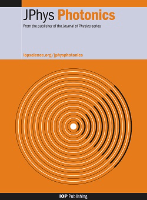
Journal of Physics-Photonics
Fostering Collaboration in the World of PhotonicsJournal of Physics-Photonics, published by IOP Publishing Ltd in the United Kingdom, is an esteemed Open Access journal that has been at the forefront of research in the field of photonics since its inception in 2018. With an impressive portfolio, the journal has achieved Q1 ranking in 2023 across multiple disciplines, including Atomic and Molecular Physics, Electrical and Electronic Engineering, and Electronic, Optical, and Magnetic Materials. This positions it among the leading journals in these areas, reflecting its significant influence and contribution to advancing knowledge and innovation. The journal aims to disseminate high-quality research findings that encompass a wide range of topics in photonics, promoting interdisciplinary approach that fosters collaboration among researchers, professionals, and students. With its commitment to open access, Journal of Physics-Photonics ensures that groundbreaking research is accessible to all, empowering a global audience to engage with and benefit from the latest advancements in photonic technologies.

Nonlinear Optics Quantum Optics-Concepts in Modern Optics
Charting New Territories in Nonlinear and Quantum OpticsNonlinear Optics Quantum Optics-Concepts in Modern Optics is a specialized journal published by OLD CITY PUBLISHING INC, focusing on the forefront of research in nonlinear optics and quantum optics. With an ISSN of 1543-0537 and an E-ISSN of 1944-8325, this journal serves as a pivotal platform for the dissemination of innovative concepts and findings in modern optics, significant for both theoretical exploration and practical applications. Established in 2003, the journal's scope encompasses critical areas such as atomic and molecular physics, optical materials, and instrumentation, attracting submissions from a diverse range of interdisciplinary fields. While the journal currently maintains a Q4 ranking in several categories, it continues to strive for higher visibility and impact in the academic community. Researchers and students alike will find valuable insights and contributions that foster advancements in optical science and engineering. With an emphasis on rigorous peer-review, Nonlinear Optics Quantum Optics-Concepts in Modern Optics is committed to enhancing the understanding and application of nonlinear optical phenomena in various technological domains.

Advanced Photonics Research
Advancing Knowledge, Shaping InnovationAdvanced Photonics Research is a leading open-access journal published by WILEY, dedicated to advancing the field of photonics through rigorous research and comprehensive reviews. With its ISSN 2699-9293, the journal aims to disseminate innovative findings in areas such as photonic materials, devices, systems, and applications. Since transitioning to an Open Access model in 2020, it has significantly increased accessibility for researchers, professionals, and students alike, promoting wider dissemination and collaboration within the global photonics community. The journal's commitment to high-quality, peer-reviewed content ensures it remains an essential resource for those seeking to stay at the forefront of photonics research. Positioned to influence both academia and industry, Advanced Photonics Research is an invaluable platform for sharing cutting-edge discoveries that drive the future of technology.
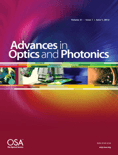
Advances in Optics and Photonics
Connecting Researchers in the Realm of LightAdvances in Optics and Photonics, published by the Optica Publishing Group, stands at the forefront of research dissemination in the fields of Atomic and Molecular Physics and Optics, alongside its prominence in Water Science and Technology. With an impressive Q1 ranking in both categories and a Scopus rank of #2/224, this journal boasts a 99th percentile status, underscoring its significance in the academic community. As a beacon of knowledge since its inception in 2009, the journal is dedicated to featuring cutting-edge research, innovative methodologies, and transformative applications in optics and photonics that can drive advancements across diverse scientific domains. While not an open-access journal, it provides vital insights for researchers, professionals, and students eager to stay updated on emerging trends and breakthroughs. With a convergence period extending to 2024, Advances in Optics and Photonics is positioned as an essential resource for anyone looking to explore the evolving landscape of light-based technologies.